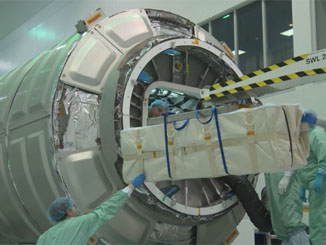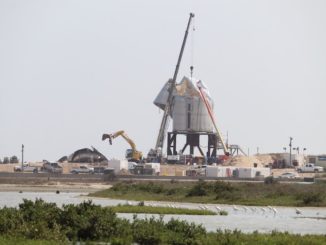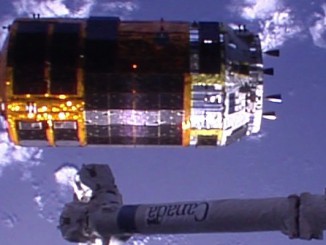
A Japanese H-2B rocket fired into orbit Tuesday from the Tanegashima Space Center with an automated cargo freighter loaded with more than 4.1 tons of batteries, experiments, spacewalk equipment, water and provisions for the International Space Station.
The unpiloted cargo ship lifted off at 1605:05 GMT (12:05:05 p.m. EDT) Tuesday from Launch Pad No. 2 at Tanegashima, an oceanfront spaceport on an island in southern Japan.
The 186-foot-tall (56.6-meter) H-2B rocket proceeded through an apparently trouble-free countdown Tuesday. After filling the rocket with super-cold liquid hydrogen and liquid oxygen propellants, the H-2B launch team managed by Mitsubishi Heavy Industries gave approval to proceed with final launch preps, culminating in ignition of two liquid-fueled LE-7A main engines at T-minus 5.2 seconds.
After passing a computer-run health check, the H-2B rocket fired four strap-on solid rocket boosters to climb away from the Tanegashima Space Center with more than 2 million pounds of thrust.
Liftoff occurred at 1:05 a.m. local time in Japan, two weeks after a previous H-2B countdown was halted by a dramatic fire on the launch pad.
Japanese engineers called off the mission’s first launch attempt Sept. 10 after the fire, and ground crews returned the H-2B rocket to its assembly building for inspections. Officials determined the fire was likely caused by static electricity and high concentrations of oxygen that dripped from the rocket’s main engines during the Sept. 10 countdown.
After instituting unspecific “corrective actions,” MHI returned the H-2B rocket to the launch pad a half-day before Tuesday’s launch to begin a new countdown.
No such trouble occurred Tuesday, and the H-2B rocket quickly turned to the southeast to climb into space over the Pacific Ocean. The precise launch time Tuesday was set to allow Japan’s eighth H-2 Transfer Vehicle to enter an orbit aligned with the orbital plane of the International Space Station, setting the stage for an automated laser-guided rendezvous Saturday.

The H-2B rocket shed its four solid rocket boosters, payload fairing, and first stage in the first six minutes of the mission. A second stage powered by a single hydrogen-fueled LE-5B engine delivered the HTV supply ship into a preliminary orbit around 15 minutes after liftoff.
Japanese mission controllers confirmed the barrel-shaped HTV launched into an on-target orbit, and the cargo freighter began charging its batteries with its body-mounted solar panels.
Tuesday’s launch made the H-2B rocket eight-for-eight in launches since debuting on Japan’s first HTV resupply mission in 2009.
The HTV 8 mission is also known as Kounotori 8. Kounotori means “white stork” in Japanese.
Packed with some 8,326 pounds (3,777 kilograms) of equipment, experiments and crew provisions, the Kounotori 8 spacecraft will approach the space station in autopilot mode Saturday. The space station crew will use the lab’s Canadian-built robotic arm to capture the HTV supply ship around 7:15 a.m. EDT (1115 GMT) Saturday, then bring the spacecraft to a berthing port on the station’s Harmony module.
The crew inside the station will get to work unpacking 5,313 pounds (2,410 kilograms) of cargo inside the HTV’s pressurized logistics carrier. Meanwhile, robots outside the station will extract a pallet from the HTV’s unpressurized cargo bay containing six lithium-ion batteries to upgrade the space station’s power system.
Astronauts Nick Hague and Andrew Morgan on the space station will conduct five spacewalks — the first is set for Oct. 6 — to begin installing the fresh batteries, which will replace aging and less-capable nickel-hydrogen batteries on the P6 solar array module on the far port side of the station’s truss backbone.
The Kounotori 8 mission will deliver the third set of six lithium-ion batteries to upgrade the space station’s four huge U.S.-built external power modules, each of which features solar array wings that span 240 feet (73 meters) tip-to-tip. The sixth HTV mission in 2016 carried the first set of new batteries to the station, followed by a second batch last year on the Kounotori 7 resupply mission.
A final set of six batteries will launch on the ninth HTV flight next year.
Each solar array section powers two electrical channels with 12 charging nickel-hydrogen batteries, and NASA is replacing the old batteries in power truss section with six lighter, more efficient lithium-ion batteries.

JAXA uses the HTV missions as part of its contribution to the space station program. Each HTV cargo freighter measures about 33 feet (10 meters) long and about 14 feet (4.4 meters) in diameter.
The Kounotori 8 mission is also carrying food, fresh drinking water, a high-pressure gas tank to recharge the space station’s internal atmosphere with oxygen and nitrogen, and spacewalking tools, such as high-definition cameras and equipment for a series of repair spacewalks planned later this year for the Alpha Magnetic Spectrometer-2 cosmic ray experiment.
The HTV will also deliver research payloads to the space station.
One of the experiments will demonstrate a high-speed satellite laser communications system developed by JAXA and Sony Computer Science Laboratories. The technology demonstrator will test a laser link with a ground station, which can accommodate higher-bandwidth communications than radio systems.
“This technology, which employs a laser for in-orbit mass-data communication, will likely be widely used not only in the telecommunications industry, but in the future as a means of communication in the field of exploration,” said Koichi Wakata, a JAXA vice president, in a statement. “Specifically, it can be used as a means of communication between the Earth and the International Space Station, the moon, and Mars. There is a wide range of potential applications, such as communication with the moon rovers.”
The Small Optical Link for International Space Station, or SOLISS, experiment will be mounted on an experiment platform outside the space station’s Japanese Kibo laboratory module.
“Sony CSL is taking advantage of the in-orbit demonstrations to complete our long-distance laser communication system,” said Hiroaki Kitano, president of Sony CSL. “It will be the first step for Sony to build upon the results of these demonstrations and put it into practical use in society as we commercialize it.
“The opportunity to use Kibo for the in-orbit demonstrations makes it possible to greatly advance the research and development of the optical communication system, much more quickly than if we had launched a small satellite for the same purpose on our own,” Kitano said. “The SOLISS system is built using consumer components. After the demonstrations, we will retrieve the SOLISS unit and perform follow-up analyses, which we expect will further accelerate our commercialization process.”
Japan’s Hourglass experiment also launched on the eighth HTV mission to help scientists investigate the behavior of soil and rock particles under low gravity, simulating the conditions future probes might encounter on a small planet or asteroid.
New hardware for a cellular biology experiment rack is also flying to the space station on the Kounotori 8 spacecraft, expanding the station’s capabilities for biological research.
Three CubeSats are also riding to the station inside the Kounotori 8 spacecraft. Once they arrive at the station, astronauts will transfer them to the Japanese Kibo module, where they will install them into a deployer for release into orbit through an airlock.
The 2-pound (1-kilogram) NARSSCube 1 nanosatellite was developed by Egypt’s National Authority for Remote Sensing and Space Science in partnership with the Kyushu Institute of Technology in Japan. It carries a low-resolution imaging camera.
The AQT-D CubeSat, which weighs 8.1 pounds (3.7 kilograms) and is about the size of a shoebox, will demonstrate a water-based satellite propulsion system. The AQT-D mission is led by the University of Tokyo.
Rwanda’s first satellite, named RWASAT 1, also launched Tuesday. Officials say the satellite will aid agricultural and environmental monitoring.
The Japanese HTV cargo delivery flight is the first of two missions launching to the International Space Station in less than 24 hours.
A Russian Soyuz crew ferry ship is set for liftoff Wednesday from the Baikonur Cosmodrome in Kazakhstan with Russian cosmonaut, NASA astronaut and the first Emirati space flier. The Soyuz MS-15 spacecraft will reach the station less than six hours after liftoff, while the HTV cargo mission is taking a longer rendezvous profile.
Email the author.
Follow Stephen Clark on Twitter: @StephenClark1.



